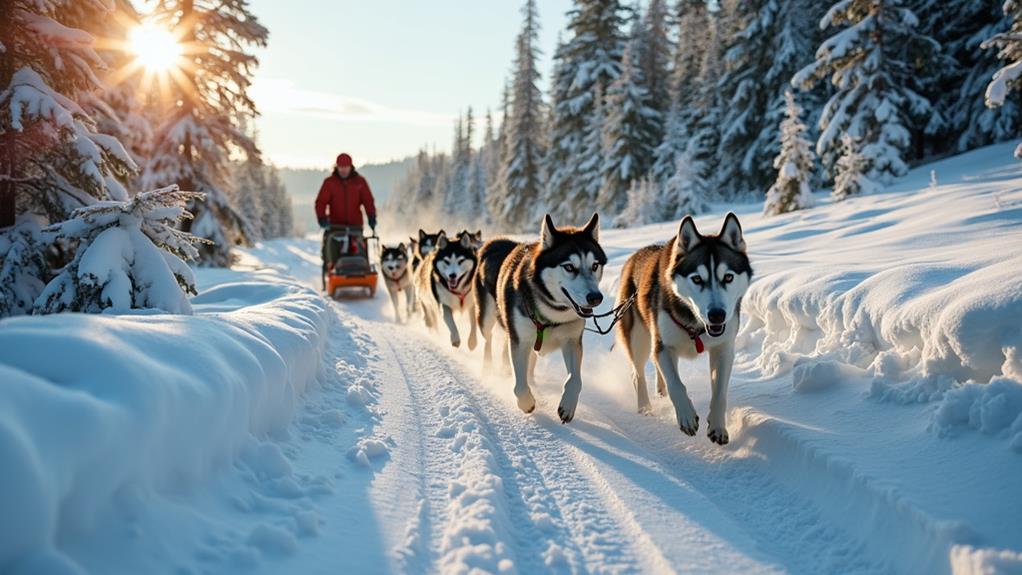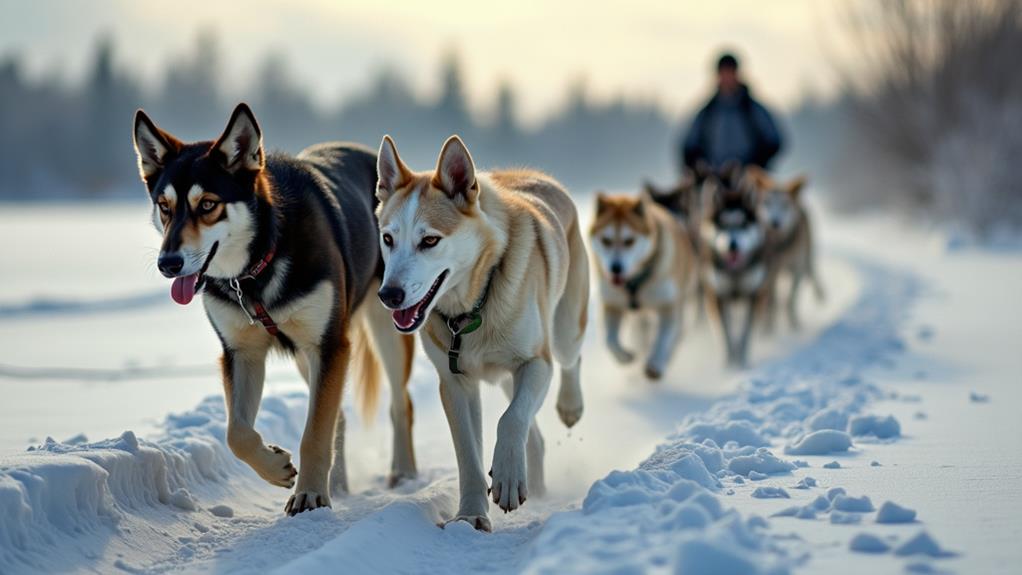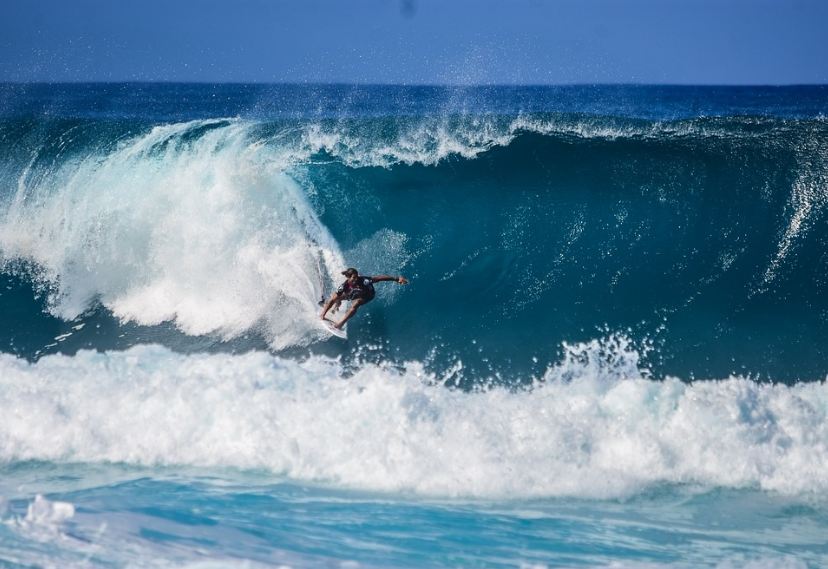What Is the Difference Between Mushing and Sledding?

When you think about winter sports, mushing and sledding might seem similar at first glance, but several key differences set them apart. Mushing involves a team of sled dogs and has deep cultural and practical roots, often associated with racing or transportation. It requires specific commands and highlights the bond between the musher and the dogs. Sledding, on the other hand, is typically a casual activity, often done without dogs or intricate techniques. Interested in the origins and unique aspects of each activity? Let's delve deeper.
History and Origins
Mushing's history dates back to at least 6000 BC, rooted in the traditions of Native American and Arctic cultures who relied on dogs for transportation and survival. These early communities used sled dogs to navigate harsh terrains and transport goods across vast, frozen landscapes. These dogs were essential partners in daily life and survival.
A pivotal event in mushing history is the 1925 serum run to Nome. In an effort to prevent a diphtheria epidemic, 20 mushers and 150 sled dogs traversed 674 miles in just 5.5 days, demonstrating the critical role sled dogs played in life-and-death situations.
The British conquest of Canada in 1760 also influenced mushing practices. The British continued using sled dogs, blending various commands and techniques that shaped modern mushing. The term "mushing" comes from the French word "marche," reflecting the cultural exchange between French Canadian and English-speaking mushers.
In contrast, recreational sledding developed separately, focusing on fun rather than structured transportation or hauling using dog teams.
Key Terminologies
Understanding the key terminologies in mushing and sledding helps distinguish these two activities. Mushing involves a team of sled dogs pulling a sled, often for sled dog racing or utility purposes. The command "mush," derived from the French word "marche!" meaning "move," instructs the dogs to start.
Sled dogs, such as Alaskan Huskies and Siberian Huskies, are bred and trained for the endurance and strength required in mushing. Mushers, the individuals who command these sled dog teams, play a critical role in guiding and controlling the dogs. In contrast, sledding is a recreational activity that doesn't necessarily involve dogs or commands. Participants simply enjoy riding down snow-covered hills.
The table below provides a quick reference to help understand the distinct terminologies in mushing and sledding:
| Term | Mushing Definition | Sledding Definition |
|---|---|---|
| Mush | Command to start moving | Not applicable |
| Sled Dogs | Dogs bred for pulling sleds | Not typically involved |
| Mushers | Individuals commanding the sled dog teams | Not applicable |
| Sled Dog Racing | Competitive events like the Iditarod and Yukon Quest | Not applicable |
Mushing Practices

Mushing practices encompass a wide range of activities, from recreational enjoyment to essential uses such as transporting goods in difficult conditions. Prominent races like the Iditarod and Yukon Quest challenge mushers and their dogs with over 1,000 miles of treacherous terrain. These practices highlight the remarkable skill and dedication required in both competitive and practical scenarios. Understanding these aspects enhances appreciation for the discipline and its historical and contemporary significance.
Utilitarian and Recreational Use
In the world of snow sports, the distinction between mushing and sledding is evident: mushing focuses on utility and competition, while sledding is geared towards fun and recreation. Mushing involves dog teams pulling a sled or rig for purposes like transporting goods through harsh conditions or racing. Sledding, on the other hand, is a recreational activity where individuals slide down snow-covered hills on a simple sled, often without the assistance of dogs.
Mushing teams can consist of 8-12 dogs or more, harnessed together to provide both power and maneuverability. This setup is crucial for navigating long distances and challenging terrains, especially in remote areas like Alaska, where mushing is recognized as an important transportation method and designated as the state sport. Conversely, sledding usually involves one or two people on a single sled, gliding down shorter, more casual slopes for enjoyment.
While mushing requires specialized training and equipment, including harnesses and sleds designed for dog teams, sledding is much simpler. You don't need extensive preparation or training—just grab a sled and find a hill. Whether you're mushing or sledding, both activities offer unique ways to enjoy winter.
Major Competitive Races
Mushing isn't just about practical transportation; it's also a thrilling competitive sport featuring some of the world's most grueling races. The Iditarod Trail, arguably the most renowned of these competitions, spans over 1,000 miles across Alaska. This iconic event showcases the endurance of both mushers and their sled dogs, who brave some of the harshest conditions imaginable. Close in prestige is the Yukon Quest, covering roughly 1,000 miles between Fairbanks, Alaska, and Whitehorse, Yukon. Known for its rugged terrain and extreme weather, the Yukon Quest pushes competitors to their limits.
Europe also hosts significant dog mushing events. La Grande Odyssée, held in the French Alps, tests teams over a distance of around 400 kilometers. It's a major event in the European mushing calendar, demanding both speed and strategy. The Finnmarksløpet in Norway is Europe's longest dog sled race, stretching approximately 1,200 kilometers. This race attracts mushers from around the globe, thanks to its challenging course and breathtaking scenery.
These competitive races not only highlight the athleticism and skills of mushers and their sled dogs but also celebrate the rich cultural heritage and history of dog mushing in each region.
Equipment and Gear
Mushing's specialized equipment distinguishes it from typical sledding activities, requiring gear such as dog sleds, harnesses, and rigging lines. Unlike recreational sledding, which often uses simple toboggans or plastic sleds, mushing necessitates advanced dog sleds. These sleds range from traditional wooden models to modern carbon fiber constructions optimized for racing.
Harnesses are crucial in mushing, designed to distribute the pulling weight evenly across a dog's body, ensuring their comfort and efficiency. Specific designs like X-back or half-back harnesses are used, which are absent in regular sledding since it doesn't involve dogs.
Additional essential mushing equipment includes snow hooks, which act as anchors to secure the sled when stopped, and picket lines for tethering the dogs. These are not needed in recreational sledding, where the focus is on gliding down hills.
Dog Roles in Teams

Understanding the roles of each dog in a mushing team is fundamental. The lead dog is at the forefront, setting the pace and direction. This position requires intelligence and the ability to follow commands precisely. Right behind the lead dog are the swing dogs, who play a critical role in maneuverability, helping guide the team around turns and ensuring smooth coordination.
The team dogs provide the majority of the pulling power. While they don't have the specialized roles of lead or swing dogs, their strength and endurance are essential for the team's overall performance. Closest to the sled are the wheel dogs. These dogs must be both strong and calm, as they bear much of the sled's weight and assist in navigating obstacles and turns.
Occasionally, a dropped dog may be removed from the team at a checkpoint for care or rest, ensuring the well-being of the team members. This practice helps maintain their health during a race or long expedition. Each role is indispensable, creating a cohesive unit that excels in the demanding sport of mushing.
Popular Competitions
Competitions in the world of mushing often captivate audiences with their thrilling displays of endurance and teamwork. The Iditarod, one of the most famous mushing competitions, challenges teams to navigate over 1,000 miles from Anchorage to Nome. Established in 1967, this dog sled race tests mushers and their dogs against extreme weather and remote conditions, making it a true demonstration of their stamina and skill.
Another iconic event in competitive mushing is the Finnmarksløpet. Held in Norway, it is Europe's longest sled dog race, spanning approximately 1,200 kilometers (around 746 miles). This race attracts participants from around the globe, all enthusiastic to tackle the rigorous expedition through Norway's challenging terrain.
In contrast to recreational sledding, which involves shorter distances and less rigorous training, competitive mushing demands significant preparation. Both mushers and their dogs undergo intense physical conditioning to meet the demands of these grueling races.
Historical events like the All Alaska Sweepstakes and the American Dog Derby also highlight the rich legacy of dog sled races. These races, dating back to the late 19th century, have helped shape the tradition and culture of mushing competitions, showcasing the enduring bond between mushers and their canine companions.
Related Sports

While competitive mushing events like the Iditarod showcase the endurance and skill of dog teams in long-distance races, several related sports blend the excitement of mushing with various outdoor activities. One such variant is bikejoring, where dogs pull a bicycle using a towline. This sport combines biking and dog training, making it a growing recreational and competitive activity. It allows participants to experience the thrill of traditional dog sledding in a different format.
Dog scootering is another exciting mushing activity. In this sport, dogs pull a human on an unmotorized kick scooter. Similar to bikejoring, dog scootering uses specialized harnesses and tow lines to ensure the safety and comfort of both dogs and humans. Community events and emerging formal racing competitions make it a fun way to engage with other enthusiasts.
While sled dog racing, with iconic events like the Iditarod and Yukon Quest, remains the most recognized form of competitive mushing, these related sports emphasize the importance of physical exercise and teamwork. They promote bonding between you and your dogs through shared outdoor experiences, highlighting both fun and endurance.
Cultural Significance
When thinking about mushing, it's essential to recognize its historical significance for Arctic survival, particularly among Native American and Inuit communities. This practice evolved from a necessity into modern competitive races, reflecting its deep-rooted cultural heritage. Understanding mushing's background helps you appreciate why it is more than just a sport—it's a vital part of history and tradition.
Historical Arctic Survival
Have you ever wondered how crucial dog sledding was for survival in the Arctic? For thousands of years, the Inuit and other Indigenous peoples relied on dog sleds to navigate the harsh, frozen landscapes. This mode of transportation was more than just a way to get from point A to point B; it was a lifeline. Imagine this:
- Early Beginnings: Around 6000 BC, the initial sleds were simple and often pulled by a single dog. These early designs laid the groundwork for more advanced sledding techniques.
- Evolution: Over time, sleds evolved to accommodate larger teams of dogs, increasing their load capacity and travel distances.
- European Adoption: When European settlers arrived in the 17th century, they quickly recognized the efficiency of sled dogs and adopted this method for winter travel and exploration.
Sled dogs were indispensable for Arctic explorers like Roald Amundsen, who relied on them to traverse uncharted territories. These dogs weren't just pets; they were essential for survival, enabling the Inuit to hunt, gather resources, and move across vast icy expanses. Dog sledding has left an indelible mark on Arctic history and culture.
Native American Practices
Understanding the historical significance of dog sledding in Arctic survival sets the stage for appreciating its cultural importance to Native American and Inuit communities. Native and Inuit people, particularly in Arctic regions, utilized dogs for transportation and hunting, relying on them to navigate harsh climates. These sled dogs were essential partners in survival, forming deep bonds with their human companions.
Sled dogs enabled Native people to transport goods and resources efficiently over long distances, facilitating trade between tribes and with European settlers. Notably, the mobility provided by sled dogs played a crucial role in territorial conflicts among tribes, such as the Iroquois, enhancing their strategic advantages.
The relationship between humans and dogs in these cultures was profound. Native practices in mushing reflected a spiritual connection and deep respect for the animals. This bond laid the foundation for modern mushing, celebrating a heritage of skills and techniques developed over thousands of years.
Here's a visual representation of these ideas:
| Aspect | Details | Importance |
|---|---|---|
| Transportation | Efficient travel over long distances | Facilitated trade and survival |
| Cultural Bond | Spiritual connection with sled dogs | Deep respect and mutual reliance |
| Territorial Claims | Mobility in conflicts | Enabled strategic advantages |
This rich history underscores the cultural significance of dog sledding among Native American and Inuit people.
Modern Competitive Races
Modern competitive dog sledding races, such as the Iditarod and Yukon Quest, epitomize endurance and skill, with mushers and their dog teams traversing over 1,000 miles of harsh terrain. These races are rich in history and cultural significance, showcasing the deep bond between humans and their canine companions.
The Iditarod, established in 1967, commemorates the 1925 serum run to Nome, a life-saving mission during a diphtheria outbreak. It symbolizes Alaskan resilience and cultural heritage. The Yukon Quest, often dubbed the "toughest race on Earth," spans between Fairbanks, Alaska, and Whitehorse, Canada, navigating some of the most challenging weather conditions imaginable.
These events transcend mere competition; they are cultural celebrations that attract thousands of spectators. They underscore the historical importance of mushing in northern communities. Key aspects include:
- Mushers: Skilled navigators guiding their teams through treacherous paths.
- Dog Teams: Dedicated dogs displaying unmatched stamina while pulling sleds.
- Global Appeal: Increasing interest has led to calls for recognition in the International Sled Dog Sport community and even the Olympics.
These races demonstrate the enduring spirit of teamwork and perseverance, highlighting the rich legacy of mushing.




